Site menu:
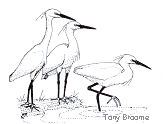
November 2008 Newsletter
Wetland bird Survey.
Cheshire & Wirral Checklist.
Heswall and Thurstaston Birding Events.
October Bird News.
Forthcoming Events.
Latest Newsletter.
The Wetland bird Survey Report 2006/07
The Wetland Bird Survey report - Waterbirds in the UK 2006/07 - has just been published. This can be viewed online, see http://www.bto.org/webs /news/AR06_07/index.htm. This national report gives us an opportunity to see how our wetland birds are doing nationally, and whether trends on the Dee Estuary are reflected nationally or due to local effects.
The total number of birds on the Dee Estuary (total of max counts) in 2006/07 was 125,433, giving a five year running mean of 134,002; this means the Dee Estuary is the eighth most important site in the country for wetland birds and has eight species in Internationally Important numbers.
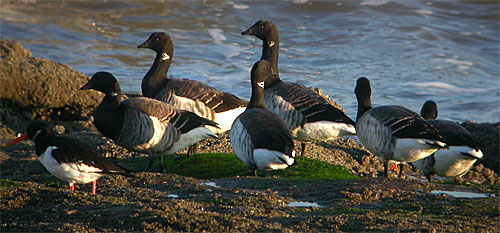
The following is a brief summary of some of our more important species.
Brent Goose (Light-bellied).
These are the birds which breed in the high arctic of Eastern Canada and mostly winter in Ireland. An all-Ireland census carried out in October 2006 resulted in a count of 28,940 with 80% of these on Strangford Lough in Northern Ireland - the population is stable. After October birds tend to disperse around the coast, with a few crossing the Irish Sea. In 2006/07 the Dee Estuary had the highest count outside Ireland with 104. This is an accurate count unlike the previous two winters when the official max WeBS counts were artificially high due to double counting. I don't know the exact circumstances for these particular years but the problem is that the Brents do tend to fly around over the high tide period. So that if, say, 50 birds are counted at Little Eye at high tide, they can then fly down to Heswall where high tide is 20 minutes later, and be counted again. Brent Geese have been rapidly increasing on the Dee Estuary since the winter of 1999/00 when numbers where typically around the 10 mark. For more details see the December 2007 newsletter.
Shelduck.
The Dee Estuary remains the second most important site in the country for this species, with the nearby Mersey Estuary the most important. In 2006/07 16,721 moulting birds were counted on the Mersey Estuary in July, a typical number for the past few years. No doubt many of these birds then flew the short distance to the Dee Estuary where we had a maximum of 10,869 in October, an increase of just under 2,000 from the previous year. 8,200 of these were off Heswall.
Teal.
The Dee Estuary bucked the national trend in 2006/07, whereas there was a sharp decline nationally, there was a sharp increase here from 2,854 to 4,429. This was the third highest count in the country, although the five year mean only puts the Dee Estuary in 11th place. The decline nationally has come after several decades of steady increase, so, as yet, there is no cause for concern.
Pintail.
The Dee Estuary remains the most important site in the country, 6,172 was the max count in 2006/07, slightly above the five year mean of 5,826. Since 1993 numbers have varied between 4,000 to just above 6,000, and it's good to see that for four of the past five years counts are at the higher end of this range.
Common Scoter.
Huge numbers continue to be counted during aerial surveys over Liverpool Bay, 63,387 were estimated to be present over Feb/Mar 2007. Many of these are out of sight of land, and those that are in sight are mostly to the west or north of the Dee Estuary and North Wirral. However, occasionally we do get a flock of thousand or more showing themselves, although the chances of large flocks occurring on the same day as a WeBS count is small. But this happened in 2006/07 with 2,009 off Hilbre in October, the fourth highest count in the country (not counting aerial surveys). The max count for the previous four years was a grand total of 40!
Little Egret.
Little Egret numbers continue to grow on the estuary, in 2006/07 we had the ninth highest count in the country with 132. In 2003/04 we had a max count of 32 which was the 37th highest count, which neatly demonstrates how much more the increase is here relative to the rest of he country.
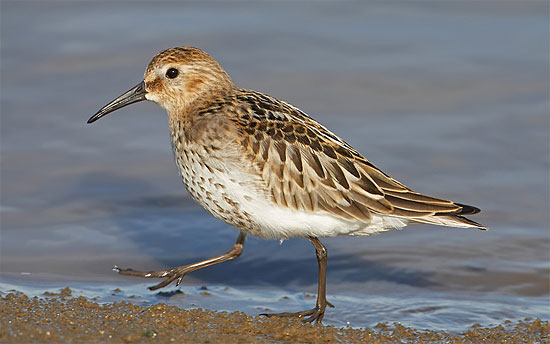
Dunlin.
Nationally counts were at their lowest since 1970, when far fewer sites were counted. Somewhat surprisingly, counts on the Dee Estuary bucked the national trend and increased to 35,834 from 19,867 the previous winter, the second highest in the country.
Black-tailed Godwit.
It was a relatively poor year for this species on the Dee Estuary, a max count of 3,713 was only the fifth highest in the country, down from 5,379 the previous year which was the second highest count. The five year mean of 4,854 is still the second highest in the country.
Curlew.
5,565 was the max count in 2006/07, fairly typical for the past few years and the fourth highest in the country. The five year mean of 5,313 is the third highest in the country.
Redshank.
Numbers were down on the Dee Estuary, reflecting the national trend. Max was 9,384 in October, but this was still the highest in the country. The previous year's count of 12,367 was the highest ever made on the estuary. The five year mean is 10,731, which, again, is the highest in the country.
Richard Smith
A Checklist of the Birds of Cheshire & Wirral
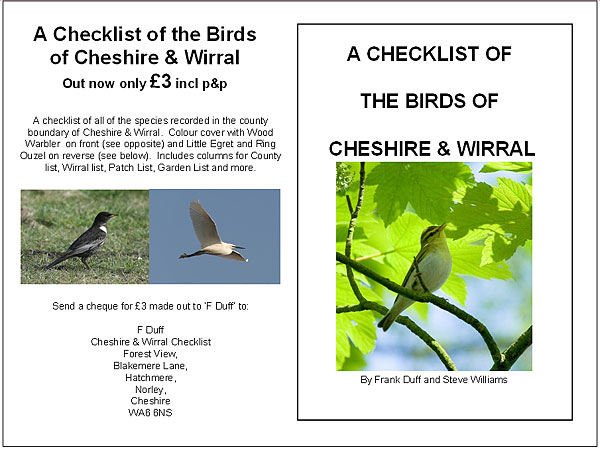
The latest checklist for all the birds recorded in Cheshire and Wirral has just been published, written by well known local birders - Frank duff and Steve Williams.
The birds in the checklist all appear within categories A, B & C of
the official B.O.U. list. The total list as of 15th October 2008 stands at
349 species*. The area covered by this checklist is that of the current
county of Cheshire and the borough of Wirral.
The authors have endeavoured to make this list as useful as possible to all
birdwatchers in Cheshire and Wirral by including four checklists within
this list:
1. If you are a keen Cheshire and Wirral 'lister' then there is a list for
all the current birds
on the list (C&W).
2. We are very aware that a number of you like to keep your 'Wirral list'
separate from
your 'complete' list and so have included a column for this area only.
3. You may also wish to keep a list for your regular 'patch'. For example,
if you regularly
go bird watching at Inner Marsh Farm RSPB, the Sandbach flashes or Frodsham
and
want to keep another list for this purpose, then this checklist allows you
to do it.
4. It would be very unusual if you didn't keep a garden list so we have
covered this option
as well.
However, also included is three further blank lists so that birders
can adopt a year list or another patch list. Remember most birders like to
see a new bird for their county or patch, so if you get the chance, and it
does not cause any issues with land owners etc, telephone or email your sighting in
to one of the information services who will then share the details of your
sighting with the many other bird watchers in the county and region.
Also, please contact this website by
if any interesting birds turn up
within the Dee estuary/North Wirral area.
* Note that Egyptian Goose, Ruddy Shelduck and Red-crested Pochard are included in the checklist; it is very difficult to assess the origins of individuals of these species (whether truly wild birds, part of a feral population or escape). Iberian Chiffchaff is also included - the 'Dibbinsdale Chiffchaff' is currently being re-assessed by the BBRC.
Heswall and Thurstaston Birdwatching Events
The area of the Dee estuary between the car park at Riverbank Road, Heswall, and the causeway which goes out across the mud at Thurstaston, is one of my favourite birdwatching haunts and I visit there several times a week over autumn and winter. You will see why I like it so much if you take a look at my site guide - published in the August 2007 newsletter. There is always a large number of birds to see and at all states of the tide. Many people from outside the area think Parkgate is the only place to visit at high tide. It can be fabulous there on a high spring tide which covers the marsh - but this only occurs three or four times a year, whereas Thurstaston and Heswall is fabulous all day every day - although you have to know where to go to see the best birds relative to the state of the tide.
One way to get to know the best places to go at different states of the tide is to join one of the birdwatching events organised by local Wirral Ranger and keen birder, Matt Thomas. These are listed below, they will also be shown in the appropriate monthly newsletter on this website and also the Birdwatching Events page. One new event is 'Mud Matters', which is something Matt and myself have been talking about for a while so I'm really glad that this is now going ahead. The walks starts at mid-tide - the sheer numbers of birds along this stretch is very impressive as the tide starts to make, with often hundreds of Knot and Black-tailed Godwits feeding right up to the beach, as well as many Teal, Pintail, Shelduck, Curlew, Redshank and Oystercatchers.
Note that the Mud'n'Marsh and Mud Matters walks are likely to be muddy, so use appropriate footwear. Total distance of the Mud'n'Marsh walk is about one mile, the Mud Matters walk is about two miles. There is no walking involved for the Marsh Matters event, and the car park overlooks the marsh.
MudíníMarsh
Saturday 15th November 2008 9.30am start and
Tuesday 10th February 2009 9am start.
Join the Rangers down at Banks Rd, Lower Heswall where the mudflats of the
Dee meet the marsh for a high tide birdwatch. From our elevated vantage
point on the shore we will watch 1000ís of waders being forced off the
mudflats by the rising tide and into the safety of the marsh. No need to
book, meet at Banks Rd car park, Lower Heswall.
For more info: (0151) 648 4371/3884
Marsh Matters
Sunday 14th December 2008 9.30am start
and
Thursday 12th March 2009 9am start.
High water on 14th December is 1205hrs, 9.7m, and on 12th March is 1200hrs,
10.0m.
Join the Rangers at Riverbank Rd car park to watch over the Dee Marshes as
the tide sweeps in.
Watch for waders, ducks, raptors and maybe an elusive Water Rail or two!
No need to book, meet at Riverbank Rd car park, Lower Heswall.
For more info: (0151) 648 4371/3884
Mud Matters
Saturday 27th December 2008 9am start and
Wednesday 28th January 2009 9.30am start.
Join the Rangers as they follow the rising tide along Thurstaston Shore.
As the channels and gullies of the mudflats fill many Redshank, Knot,
Curlew and Dunlin will be forced into the open and Pintail will start to
drift towards the Heswall Marshes. We will then return to the Visitor
Centre via Heswall Fields and the Wirral Way where we will look for
hedgerow and farmland birds.
No need to book. Meet at the Wirral Country Park Visitor Centre,
Thurstaston.
For more info: (0151) 648 4371/3884.
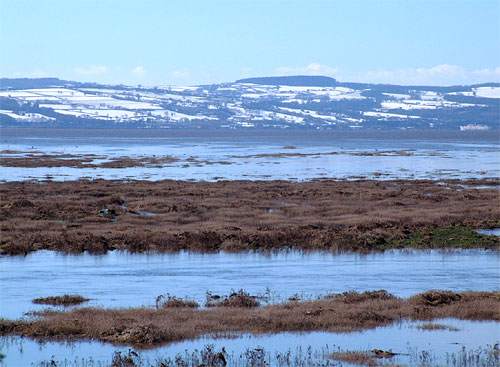
Gutter is in the foreground, you can see the ripples the tide is making as it rushes by.
© Richard Smith.
October Bird News
This month's bird news was dominated by a report of a Snowy Egret off Meols Shore on Oct 18th. If confirmed, this would be the second ever for this country, the first being in 2002 on the west coast of Scotland and, no doubt, the rarest bird ever seen in Wirral and probably the whole of Merseyside. It was reported by an experienced birder who gave a good description, but, unfortunately, photographs of the bird were distant and inconclusive. Some birders saw a Little Egret (probably a juvenile) on Oct 19th with pale legs and lores (the area between the eye and bill), and thought that this may have been mistaken for a Snowy Egret in the bright sunshine of the morning of the 18th. Until it turns up again, or a good photo emerges from the 18th, we will never know for sure.
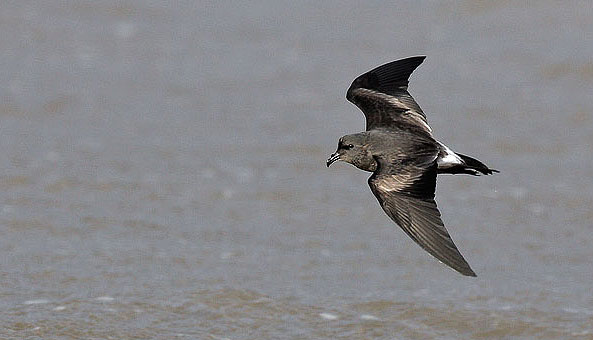
You will recall that my wish list for October began with a north-west gale for the first week - which is exactly what we got! This brought in 120 Leach's Petrels past Hilbre on the 1st, with 107 the following day. Other good birds included Arctic, Long-tailed, Pomarine and Great Skuas, Sabine's Gull, Little Gulls, Grey Phalaropes and Long-tailed Duck. 773 Black-tailed Godwits sheltered from the gales in a field next to Gilroy Nature Park, West Kirby, a remarkable number for a site where, before this year, 77 would have been regarded as a very high count! Around 3,000 Black-tailed Godwits were seen at Connah's Quay for most of the month.
The weather settled down after the gales and a couple of Curlew Sandpipers turned up at Connah's Quay and one at Heswall, two Sandwich Terns were on West Kirby Shore. Max counts of Greenshank and Spotted Redshank were 11 and 10 respectively, both at Connah's Quay, and there were two reports of single Common Sandpipers. Wader numbers have been good without being spectacular, but 20,000 Knot off Meols on the 20th was a good count for October. Two Spoonbills flew over the Connah's Quay reserve early in the month, and there were several reports of a single Spoonbill way out on Burton Marsh. Strong west winds on the 26th brought in a single Leach's Petrel past Hilbre and Point of Ayr.
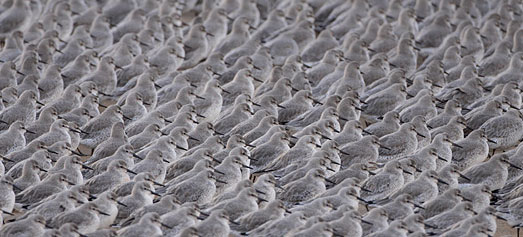
Despite no big tides to cover the marsh good numbers of Short-eared Owls have been seen, with one report of 21 early in the month, this was the total for the whole estuary but a very high count, nevertheless. 14 were counted with one sweep of the telescope on Oct 26th on Burton Marsh. A few Barn Owls have also been on the marsh at both Burton and Parkgate, it must be a good vole year! Up to three Hen Harriers have been observed going in to the roost at Parkgate, and one Marsh Harrier flew over West Kirby.
We had four Brent Geese present at Hilbre at the beginning of the month, but these increased rapidly to reach 94 by the end, an excellent count and the highest ever for October. Can we reach 200 by the end of the winter???!! Other interesting birds include a Snow Bunting at West Kirby on the 27th and a Black Redstart on Hilbre on 30th. A Green-winged Teal was reported from Inner Marsh Farm on a couple of dates.
What to expect in November
Although technically still autumn November is regarded by most birdwatchers and birds as the first month of winter. If we get some cold and still conditions expect wader numbers to increase rapidly, particularly Knot and Dunlin. Rarer waders may well include Greenshank and Spotted Redshank, and even a late Curlew Sandpiper. Those same still conditions would also be ideal to see the large Great Crested Grebe flock off Meols, look out for any attendant rarer grebes and divers. Good numbers of Red-breasted Mergansers and Goldeneye should return, with West Kirby Marine Lake the best place to see these. Brent Geese numbers are likely to get close to, or even exceed, 100 on Hilbre island - the best place to see these is from Hilbre itself at low tide, or from West Kirby shore at high tide - they are usually around Little Eye at high tide, but sometimes come right up to the marsh at West Kirby.
In contrast, last November's prolonged north-west gales reminded us that it was still late autumn, blowing in both Leach's and Storm Petrels, a good selection of skuas and a Grey Phalarope.
On the marshes expect to see Hen Harriers and Short-eared Owls, early indications are that it is going to be a good winter for both these species, and we might well get a late Marsh Harrier or two.
Forthcoming Events
November Highest Spring Tides (Liverpool)
Also see
Tides page.
14th November, 11.30hrs (GMT), 9.7m.
15th November, 12.15hrs (GMT), 9.6m.
Forthcoming Events
Organised by the
Wirral Ranger Service ,
Flintshire Countryside Service and/or the RSPB:
All these events and walks have bird interest, even those not advertised
specifically for birdwatching. No need to book for these events unless
specified - please check below.
Saturday 1st November
Free Guided Walk, Flint Saltmarsh, Meet at the Flint
Lifeboat stn Car park 10.30am.
Join RSPB warden for spectacular views of Black Tailed Godwit and other
birds. Wellingtons Advisable.
No need to book, further details call 0151 336 7681.
Note that the two events on 15th November, below, can be easily combined. Heswall is best before high tide, i.e. from 9.30am to 10.30am. Leaving the Mud'n'Marsh event at 10.30am leaves plenty of time to get to Hoylake to see the high tide there.
Saturday 15th November 9.30am start,
MudíníMarsh.
Join the Rangers down at Banks Rd, Lower Heswall
where the mudflats of the
Dee meet the marsh for a high tide birdwatch. From our elevated vantage
point on the shore we will watch 1000ís of waders being forced off the
mudflats by the rising tide and into the safety of the marsh. No need to
book, meet at Banks Rd car park, Lower Heswall. This event includes a
one mile walk and is likely to be muddy, please use appropriate footwear.
For more info: (0151) 648 4371/3884.
Saturday 15th November, 9.45am to Noon (high tide at 11.41am),
Kings Gap High Tide Birdwatch (Hoylake).
Come and join the Rangers and
Voluntary Wardens watching the huge high tide wader roost at Kings Gap,
Hoylake. Expect to see thousands of Dunlin, Knot and Oystercatcher, and
hundreds of Grey Plover, Sanderling and Curlew - a magnificent sight!
Telescopes will be on hand for you to look at the birds, and experts will
be there to help you identify the birds. The Rangers will be there from
9.30am, high tide is at 11.41am, so I would advise arriving an hour before
high tide so you can see the birds getting pushed in by the sea.
Sunday 23rd November 2.30pm, Parkgate Raptor Watch.
Come along and watch birds of prey with the experts. See the graceful hen
harriers coming in to roost on the RSPB reserve. Other birds of prey we
hope to see are merlin, peregrine, sparrowhawk, short-eared owl and barn
owl. Meet at the Old Baths car park, which overlooks the Dee Estuary RSPB
Reserve at Parkgate, close to The Boat House pub. No need to book.
Sunday 14th December 9.30am start,
Marsh Matters. High tide at 1205hrs, 9.7m.
Join the Rangers at Riverbank Rd car park to watch over the Dee Marshes as
the tide sweeps in.
Watch for waders, ducks, raptors and maybe an elusive Water Rail or two!
No need to book, meet at Riverbank Rd car park, Lower Heswall.
For more info: (0151) 648 4371/3884
|
 |
The blank (UK) Birding Webring is a collection of quality birding web sites that are based in the United Kingdom. Visit the webring homepage for more information, or A complete list of all the sites in the webring is available by clicking here. previous site in ring : random site in ring : next site in ring |